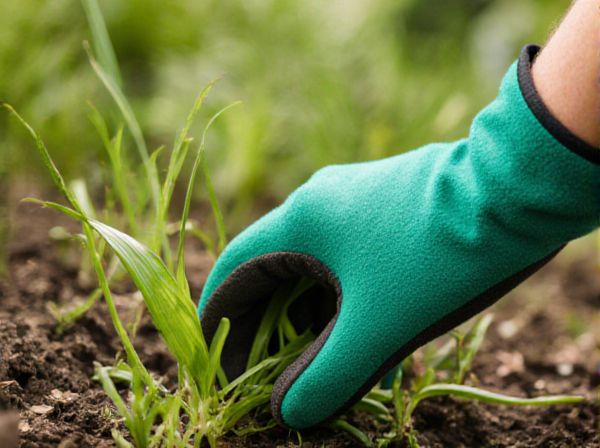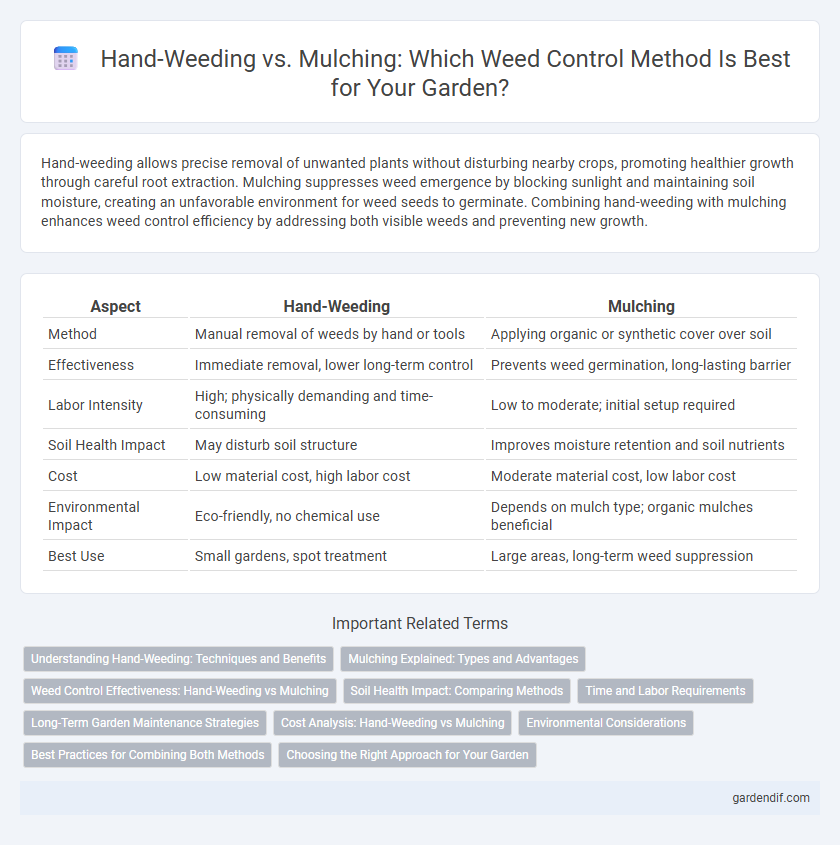
Hand-weeding vs Mulching Illustration
Hand-weeding allows precise removal of unwanted plants without disturbing nearby crops, promoting healthier growth through careful root extraction. Mulching suppresses weed emergence by blocking sunlight and maintaining soil moisture, creating an unfavorable environment for weed seeds to germinate. Combining hand-weeding with mulching enhances weed control efficiency by addressing both visible weeds and preventing new growth.
Table of Comparison
| Aspect | Hand-Weeding | Mulching |
|---|---|---|
| Method | Manual removal of weeds by hand or tools | Applying organic or synthetic cover over soil |
| Effectiveness | Immediate removal, lower long-term control | Prevents weed germination, long-lasting barrier |
| Labor Intensity | High; physically demanding and time-consuming | Low to moderate; initial setup required |
| Soil Health Impact | May disturb soil structure | Improves moisture retention and soil nutrients |
| Cost | Low material cost, high labor cost | Moderate material cost, low labor cost |
| Environmental Impact | Eco-friendly, no chemical use | Depends on mulch type; organic mulches beneficial |
| Best Use | Small gardens, spot treatment | Large areas, long-term weed suppression |
Understanding Hand-Weeding: Techniques and Benefits
Hand-weeding involves manually removing weeds by grasping and pulling them from the soil, targeting the roots to prevent regrowth. This technique is highly effective for maintaining garden health without chemical herbicides, promoting organic gardening practices. Benefits include precision in weed control, minimal soil disturbance, and preservation of beneficial organisms, making it ideal for small-scale and sensitive landscapes.
Mulching Explained: Types and Advantages
Mulching involves covering the soil with organic materials such as straw, wood chips, or compost to suppress weed growth, retain moisture, and improve soil health. Types of mulch include organic options like bark mulch, grass clippings, and leaf mold, as well as inorganic materials such as plastic sheeting and landscape fabric. Mulching not only reduces hand-weeding labor by preventing weed seed germination but also enhances soil fertility and temperature regulation.
Weed Control Effectiveness: Hand-Weeding vs Mulching
Hand-weeding provides precise removal of weeds but is labor-intensive and may miss root fragments, leading to regrowth. Mulching effectively suppresses weed germination by blocking sunlight and maintaining soil moisture, reducing overall weed density significantly. Combining hand-weeding with organic or plastic mulches enhances weed control by targeting existing weeds and preventing new growth simultaneously.
Soil Health Impact: Comparing Methods
Hand-weeding preserves soil structure by minimizing disturbance, promoting beneficial microbial activity and nutrient cycling. Mulching enhances soil moisture retention and temperature regulation while suppressing weed growth, supporting diverse soil organisms. Both methods improve soil health, but integrating hand-weeding with organic mulches offers synergistic benefits for long-term soil fertility.
Time and Labor Requirements
Hand-weeding demands significant time and physical effort, often requiring frequent attention to effectively manage weed growth in garden beds or large agricultural plots. Mulching reduces labor by creating a barrier that suppresses weed emergence, thereby decreasing the frequency and intensity of weeding sessions. Comparing both methods, mulching offers a more time-efficient and less labor-intensive solution for long-term weed control in various cropping systems.
Long-Term Garden Maintenance Strategies
Hand-weeding provides precise removal of unwanted plants, ensuring minimal disturbance to soil and desirable vegetation, which supports long-term garden health. Mulching suppresses weed germination and retains soil moisture, improving soil structure and reducing erosion over time. Combining both methods enhances sustainable garden maintenance by reducing weed pressure and promoting robust plant growth.
Cost Analysis: Hand-Weeding vs Mulching
Hand-weeding demands significant labor hours, escalating costs especially for larger areas, while mulching presents a cost-effective alternative by reducing weed growth and conserving soil moisture, which lowers irrigation expenses. Initial mulching materials and application can involve moderate upfront investment, but long-term savings arise from decreased labor and maintenance needs. Evaluating local labor rates and mulch availability is essential for accurate cost comparison between these weed control methods.
Environmental Considerations
Hand-weeding minimizes soil disturbance and reduces chemical runoff, supporting healthier ecosystems and promoting biodiversity. Mulching conserves soil moisture, suppresses weed growth naturally, and enhances soil organic matter, contributing to carbon sequestration. Both methods reduce reliance on herbicides, lowering environmental pollution and protecting beneficial soil organisms.
Best Practices for Combining Both Methods
Combining hand-weeding with mulching maximizes weed control by targeting both visible and emerging weeds while maintaining soil moisture and temperature. Applying a 2-3 inch layer of organic mulch like straw or bark effectively suppresses weed seeds, while regular hand-weeding removes persistent weeds and prevents seed dispersal. Best practices include monitoring mulch depth to avoid smothering desired plants and scheduling hand-weeding sessions during early weed growth stages for optimal results.
Choosing the Right Approach for Your Garden
Hand-weeding offers precise control for removing weeds without disturbing garden plants, making it ideal for small or delicate areas. Mulching suppresses weed growth by blocking sunlight and retaining soil moisture, which benefits larger garden beds and reduces maintenance time. Selecting the right approach depends on garden size, plant types, and desired labor investment, ensuring effective weed management and healthy plant growth.
Hand-weeding vs Mulching Infographic

 gardendif.com
gardendif.com